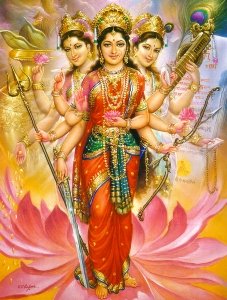Essence Of Devi Bhagavatha Purana |
|
 |
Nadis and Chakras Devi Bhagavati described to Himavanta about physiological cum psychological analysis of human body, especially of various Nadis (Life webs) and Chakras. The word ‘Nad’ means streams; in the context of Yoga, Nadis are channels of Kundalini Energy as also of connectors of nerves or ‘Snayus’. The subtle yoga channels of energy from mind as well as ‘Chitta’ or consciousness of the self are through various physiological cords, vessels/tubes, nerves, muscles, arteries and veins. |
There are 350,000 Nadis in human body(Ayurveda) mentioned 7,50, 000 Nadis) but the principal nadis are fourteen viz.Sushumna, Ida, Pingala,Gandhari, Hastajihva, Yashasvini, Pusha, Alambusha, Kuhu, Shankini, Payasvini, Sarasvati, Varuni and Yashodhara. The most important Nadis however are the first three above. Sushumna is at the center of the spinal cord and is of the nature of Moon, Sun and Agni or Fire. It originates from Sacral plexus or a network of nerves at the spinal base upto the head at the top; it is from Moola Adhara Chakra and terminating at Sahsarara Chakra. Normally, Sushumna is inactive except when pranayama is performed. ‘Ida’ nadi is to the left of Sushumna, representing moon providing nectar like energy and ‘Pingala’ nadi is to the right side of Sushumna providing male like power. There is a cobweb like formation in the innermost area of Sushumna, called Vichitra or Chitrini Bhulinga Nadi, the centre of which is the seat of Ichha Shakti ( Energy of Desire), ‘Jnana Shakti’ ( Energy of Knoweldge) and ‘Kriya Shakti’ (Energy of Action). The middle portion of the Bhulinga nadi has the luminosity of several Suns, above which is the Maya Bija Haratma representing the sound like ‘Ha’. Thereabove is ‘Kula Kundalini’ representing Serpent Fire of red colour. Outside the Kundalini is the ‘Adhara Nilaya’ of yellow lotus colour denoting four letters viz. Va, Saa, Sa, Sa; this is the base or Moola Adhara supported by six lotus formations. Beyond the Moola Adhara is the Manipura Chakra of cloud lightning colour comprising ten lotus petals representing ten letters da, dha, na, ta, tha, da, dha, na, pa, pha. This Mani Padma is the dwelling spot of Vishnu. Beyond the Mani Padma is’ Anahata Padma’ with twelve petals representing Kha, Ga, Gha, ma, cha, chha, ja, jha, lya, ta, tha. In the middle is Banalingam, giving out the sound of Sabda Brahma. Therafter is Rudra Chakra which represents, sixteen letters : a, a’, i, i’, u, u’, ri, ri’, li, lri, e, ai, o, ar, am, ah. It is in this place that ‘Jeevatma’ gets purified into ‘Paramatma’ and hence known as ‘Visuddha Chakra’ . Further beyond is ‘Ajna Chakra ’ in between the two eyebrows where the ‘self ’ residesrepresenting two letters ha, and ksha, one commanding another or Paramatma commanding Jeevatma. Even above is the ‘Kailasa Chakra’ which Yogis call as Rodhini Chakra the central point is the ‘Bindu Sthan’. In other words, a perfect Yogi has to perform Puraka, Pranayama, fix the mind on Mooladhara lotus, contract and arouse Kundalini Shakti by lifting by ‘Vayu’ between anus and genitals, pierce through the Adi Swayam Linga through various lotus petals and lotuses as described above, reach Sahasrara or thousand petal lotus and Bindu Chakra by the Union of Prakriti and Purusha. Could there be another example of the breaking of barriers as delineated in ‘Lalitha Sahasranama’ as follows! ‘Mooladharaika nilaya,Brahma Grandhi vibhedini/ Manipurantharuditha Vishnu grandhi vibhedini/ Ajna Chakrantharalakstha Rudragrandhi vibhedini/ Sahasraambujarudha/ Sudha Sarabhi Varshinii / Tatillatha Samaruchih Shatchakropathi Samsthita / Mahasakthih Kundalini/ bisathanthu taniyasi/ Indeed it would be rather difficult to practise Yoga on the above lines and hence would adopt ‘Avayava Yoga’( limb wise) initially as described above viz. overcome ‘Shadvargas’ and practise Yama, Niyama, Asana, Pranayama, Prathyahara, Dharana,Dhyana and Samadhi and then after lapse of many weeks and months of practice one could succeed in the above discipline! |
|
| Devi Bhagavata Purana Home |
Back to the News Page